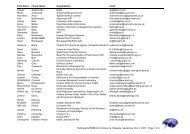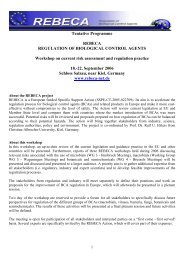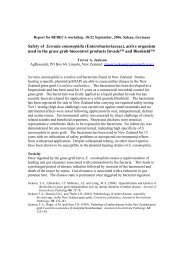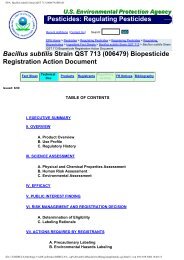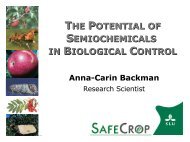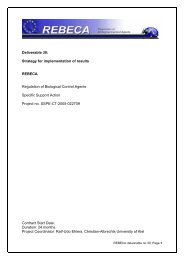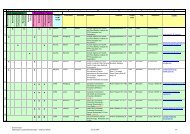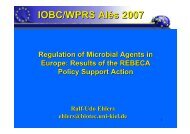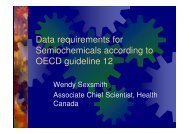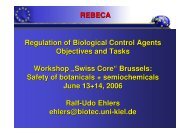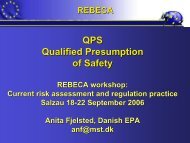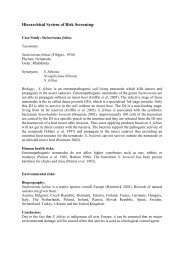Deliverable 28: Specification of low risk products REBECA ...
Deliverable 28: Specification of low risk products REBECA ...
Deliverable 28: Specification of low risk products REBECA ...
You also want an ePaper? Increase the reach of your titles
YUMPU automatically turns print PDFs into web optimized ePapers that Google loves.
The multiplication <strong>of</strong> non-target <strong>risk</strong>s with persistence and dispersal factors is in our<br />
opinion the only appropriate way to account for the elevated <strong>risk</strong> resulting from<br />
increased exposure <strong>of</strong> non-targets.<br />
There are three factors at play which affect environmental pesticide <strong>risk</strong>: these are<br />
label rates, formulation type, and application method. We consider it necessary to<br />
calculate the <strong>risk</strong> indicator on an application basis for the end-use product, as label<br />
rates, application method and formulation will strongly affect environmental exposure.<br />
Scoring and rationales<br />
Persistence. Persistence <strong>of</strong> an active ingredient in the environment is an important<br />
factor in determining its <strong>risk</strong> because it strongly influences the likelihood for nontarget<br />
organism exposure. However, it is a difficult task to define a scoring system<br />
where conventional chemicals and microbials can be fairly compared. Clearly, living<br />
organisms can have an entirely different behaviour in the environment than<br />
chemicals in that they can proliferate in the environment. On the other hand microorganisms<br />
<strong>of</strong>ten have a narrow host range and may, in the absence <strong>of</strong> a suitable host<br />
for proliferation, degrade in the environment similarly to chemical substances.<br />
Further, it is important to note that, from a <strong>risk</strong> assessment perspective, an organism<br />
or substance naturally present in the environment must be regarded differently than a<br />
new species or substance introduced into an ecosystem.<br />
We postulate that a naturally occurring substance or organism will pose no additional<br />
<strong>risk</strong> to the environment if introduced into a comparable system at similar<br />
concentrations. For instance, the concentrations <strong>of</strong> entomopathogenic fungi <strong>of</strong>ten<br />
heavily fluctuate depending on host densities and micro-climatic conditions, and<br />
concentrations found during naturally occurring epizootics are <strong>of</strong>ten as high as those<br />
found after artificial inoculations (Kessler, 2004; Laengle, 2005).<br />
Therefore, a relatively high and persistent concentration <strong>of</strong> an indigenous organism in<br />
the environment, even if a result <strong>of</strong> artificial inoculation, does not necessarily add an<br />
environmental <strong>risk</strong>. Contrarily, persistence <strong>of</strong> non-indigenous micro-organism in the<br />
environment also means prolonged exposure <strong>of</strong> potential non target organisms that<br />
may never have been previously exposed to the micro-organism. Likewise, persistent<br />
or increasing concentrations <strong>of</strong> a micro-organism in the absence <strong>of</strong> its natural host<br />
could be an indicator <strong>of</strong> vegetative growth or even multiplication in non-target hosts.<br />
To account for these considerations in a systematic manner, we propose to score the<br />
persistence component in our <strong>risk</strong> indicator as laid out in Table 1. The persistence<br />
score for both chemicals and microbials is dependent on its half-life in the absence <strong>of</strong><br />
the target host, where the half-life is the highest value from all environmental<br />
compartments. The reduced <strong>risk</strong> for indigenous micro-organisms and naturally<br />
occurring substances is taken into account by assigning a <strong>low</strong> persistence score if<br />
concentrations return to levels comparable to natural concentrations within one or<br />
two years <strong>of</strong> application.<br />
Table 1 Scores assigned for persistence <strong>of</strong> the assessed active ingredient. Values<br />
are assigned based on its half-life in the environmental compartment where the agent<br />
is most stable, or based on the percentage <strong>of</strong> CFUs (colony forming units) <strong>of</strong> BCA<br />
found one or two years post application (in target absence).<br />
20



